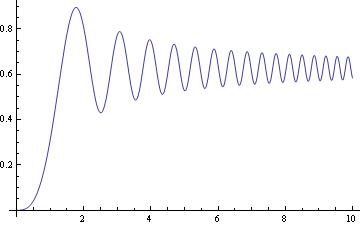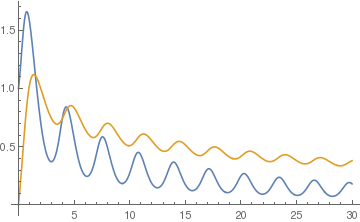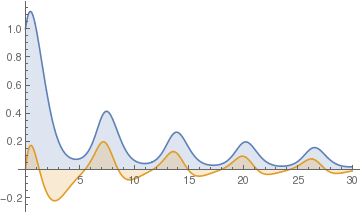Preface
This section demontrates applications of standard Mathematica command NDSolve for solving differential equations numerically. It will be widely used in other sections of this tutorial.
Return to computing page for the second course APMA0340
Return to Mathematica tutorial for the first course APMA0330
Return to Mathematica tutorial for the second course APMA0340
Return to the main page for the course APMA0330
Return to the main page for the course APMA0340
Return to Part III of the course APMA0330
Glossary
Numerical Solutions
Although sometimes Mathematica is able to solve a differential equation, in practice we tend to rely on numerical methods to solve differential equations. Most differential equations that are found in actual practice are much too complicated to express a solution using elementary or special functions. Usually, we want to obtain a solution in implicit form, but unfortunately this only happens occasionally. It is important to note that because a differential equation does not have an explicit or implicit solution does not necessarily mean that the solution does not exist.
Since a differential equation contains an unbounded derivative operato, we do not expect to obtain numerically the general solution that includes arbitrary constants. Instead, we knock out one solution by considering the initial value problem (IVP for short)
Example: Consider the initial value problem \( y' = \sin \left( x^2 \right) , \quad y(0) =0 . \) We try to find its solution using the standard Mathematica command DSolve:

|
Now we solve the same problem numerically using NDSolve.
numsol = NDSolve[{y'[x] == Sin[x^2], y[0] == 0}, y[x], {x, 0, 10}]
Out[3]= {{y[x] -> InterpolatingFunction[{{0., 10.}}],<>],[x]}}
Plot[y[x] /. numsol, {x, 0, 10}, PlotRange -> All]
 |
|
| Frensel integral. | Mathematica code |
We calculate its approximate value at, say, x=6.5 as follows:
This indicates that y(6.5) approximately equal to 0.639918. We can improve accuracy by choosing the option PrecisionGoal.
There are two main approaches to finding a numerical value for the solution to the initial value problem \( y' = f(x,y), \quad y( x_0 )= y_0 . \) Its solution can be obtained using either DSolve (for solutions represented using known functions, if it is possible) or NDSolve (for numerical solutions). The first one is based on definition of the slope function f(x,y) as an expression. The second one (which is recommended) is to define the slope as a function. To see how it works, let us consider an example.
A general approach for determing numerically solutions of the initial value problems and then plot them using Mathematica's capability is as follows. We demostrate all steps on the following initial value problem (IVP, for short):

|
To see a numerical value at, say x=3.0, we type: y[x] /. a /. x -> 3.0
Out[3]= {-0.333563}
a = NDSolve[{y'[x]== (1-x)/(1+y[x]^5),y[0]==1}, y[x],{x,0,3}];
Since its solution is known in implicit form, there is an alternative way to plot the graph:
Plot[y[x] /. a, {x,0,3}] psi[x_, y_] = y + 1/6 y^6 - x + 1/2 x^2 - 7/6;
ContourPlot[psi[x, y] == 0, {x, 0, 2}, {y, -1, 3}, ContourLabels->True, ColorFunction->Hue] |
|
| Contour plot. | Mathematica code |
■
http://library.wolfram.com/infocenter/Books/8503/AdvancedNumericalDifferentialEquationSolvingInMathematicaPart1.pdf
Example: Consider the slope function f(x,y) = 1/(3*x - 2*y + 1). Then we find a numerical value treating f(x,y) as an expression.
Now we use the function DSolve to find the explicit solution:
Solve::ifun: Inverse functions are being used by
Solve, so some solutions may not be found; use
Reduce for complete solution information. >>Example: Consider the initial value problem (IVP) for the Riccati equation:
y[x] /. sol /. x -> 3
http://library.wolfram.com/infocenter/Books/8503/AdvancedNumericalDifferentialEquationSolvingInMathematicaPart1.pdf
As we see applications of NDSolve
are very straightforward --- use the solution "interpolating function" as
a regular function. When plotting the solution, Mathematica recommends to use the Evaluation. We give some examples.
Example: We consider the initial value problem for the oscillating slope function

|
First, we solve a
first-order ordinary differential equation, which gives you decaying oscillations:
sol1 = NDSolve[{y'[x] == y[x] Sin[2 x + y[x]], y[0] == 1}, y, {x, 0, 30}];
Now we use it inside another equation. The important thing to remember
is that the domain of the previous equations should be equal to or
contain the domain of the next equations.
sol2 = NDSolve[{z'[x]== -z[x]^2+First[Evaluate[y[x] /. sol1]], z[0] == 0}, z, {x, 0, 30}]
Then we plot both solutions. Indeed, first solution here plays the role of sort of a driving force, so on the graphs
below you see synchronization between oscillations.
Plot[{Evaluate[y[x] /. sol1], Evaluate[z[x] /. sol2]}, {x, 0, 30}, PlotRange -> All]
|
|
| Two solutions. | Mathematica code |

|
Now you can do more advanced things, like using also derivative of the "Interpolating Function" inside of new equations:
sol3 = NDSolve[{y'[x] == y[x] Cos[x + y[x]], y[0] == 1}, y, {x, 0, 30}];
sol4 = NDSolve[{z'[x]== -z[x]+First[y[x]/5 + y'[x] /. sol3], z[0] == 0}, z, {x, 0, 30}]; Plot[{Evaluate[y[x] /. sol3], Evaluate[z[x] /. sol4]}, {x, 0, 30}, PlotRange -> All, Filling -> 0] |
|
| The solution and its derivative. | Mathematica code |
■
Return to Mathematica page
Return to the main page (APMA0330)
Return to the Part 1 (Plotting)
Return to the Part 2 (First Order ODEs)
Return to the Part 3 (Numerical Methods)
Return to the Part 4 (Second and Higher Order ODEs)
Return to the Part 5 (Series and Recurrences)
Return to the Part 6 (Laplace Transform)
Return to the Part 7 (Boundary Value Problems)